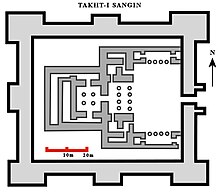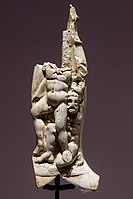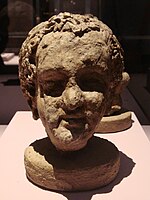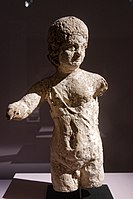 Hellenistic silenus Marsyas from Takhti Sangin, with dedication in Greek to the god Oxus, by "Atrosokes", a Bactrian name. Temple of the Oxus, Takht-i Sangin, 200-150 BC. National Museum of Antiquities of Tajikistan.
Hellenistic silenus Marsyas from Takhti Sangin, with dedication in Greek to the god Oxus, by "Atrosokes", a Bactrian name. Temple of the Oxus, Takht-i Sangin, 200-150 BC. National Museum of Antiquities of Tajikistan.


Takht-i Sangin (Tajik: Тахти Сангин, lit. 'Throne of Stone'") is an archaeological site located near the confluence of the Vakhsh and Panj rivers, the source of the Amu Darya, in southern Tajikistan. During the Hellenistic period it was a city in the Greco-Bactrian kingdom with a large temple dedicated to the Oxus (Vakhsh river), which remained in use in the following Kushan period, until the third century AD. The site may have been the source of the Oxus Treasure.
Description
Takht-i Sangin is located on a raised flat area sandwiched between the west bank of the Amu Darya river and the base of the Teshik Tosh mountain to the west. This terrace is about three kilometres long from north to south and varies from 100 to 450 metres in width. The site is immediately south of the point where the Vakhsh / Amu Darya river (the ancient Oxus) is met by the Panj river (the ancient Ochus), about five kilometres north of Takht-i Kuvad, where the Oxus Treasure was discovered. Another significant Greco-Bactrian site, Ai Khanoum, is also located on the Panj river, a little over a hundred kilometres to the east. Pottery finds indicate that the whole terrace of Takht-i Sangin was populated in the third and second centuries BC. The river and the mountain provided natural defences on the eastern and western sides of the settlement, but city walls bounded the city at the north and south ends. Further east-west walls divided the site into a number of sections. The site could not have been supported from the very limited arable land in the area immediately surrounding it. The site's political and/or religious significance must have enabled it to draw on resources from further afield. Lindström proposes that the settlement and its temple functioned as the central religious site for the worship of Oxus for the whole of Bactria. In the 130s BC, the site was sacked, probably by the Kushans and under their rule most of the site was abandoned.
Temple of Oxus

In the middle of the terrace, there was a citadel, measuring around 170-210 metres by 240 metres, on top of a ten-metre-high artificial mound. This mount was surrounded by a ditch and a two-metre-high stone wall on the northern, western, and southern sides. On the eastern side it bordered the river, and there are traces of a dock, which is now inaccessible.

The centre of the citadel contained the Oxus Temple, which was first built around 300 BC. The size of the temple suggests that its construction was financed by an external authority, probably the Seleucids. The temple is surrounded by a massive mud-brick wall with tower-like projections at the corners and in the centre of each side. The wall is 6 metres thick, 85 metres wide in a north-south direction and 100 metres long in an east-west direction. A propylon (gateway) in the east side of this wall leads to a large courtyard containing dedications and altars, measuring 44 metres north-south by ca. 20 metres east-west. This temple building is oriented to the compass directions, with its entrance facing east, towards the river. It is made of mud-brick with a flat roof and measures 44 metres wide and 50 metres long. The facade of the temple building stretches along the whole western side of the courtyard. At the centre of the facade is an aiwān (a pillared vestibule), with two rows of four columns. This is flanked on the left and right by wings, each with three rooms and a small tower. Behind the aiwān is a square central hall measuring about 11.5 x 12.7 metres, with four columns supporting the roof. There are blocks of stone at the back of the hall, probably the base of a cult image. Doors on the south and north sides of this hall leading to two corridors, which each wrap around the central hall in an L-shape.
The excavators, Igor Pichikyan and Boris Litvinsky, argued that the temple was the earliest known Zoroastrian fire temple, because they found remains of ashes in the rooms in the wings flanking the aiwān and pits filled with pure ashes in the central hall. Lindström disputes this interpretation, since the pits in the central hall are located under the columns and seem to be foundation deposits, because there is no evidence for a fire-altar in the central hall, and because there is a Greek-style sacrificial altar in the courtyard.
Votive finds

Somewhere between 5,000 and 8,000 other votive offerings in gold, silver, bronze, iron, lead, glass, plaster, terracotta, precious stones, limestone, shell, bone, ivory, and wood have been found. Most of these were located in the central hall of the temple and the corridors behind it, both above ground and in buried caches. These votives include portraits of Greco-Bactrian kings, jewellery, and furniture, but especially weapons and armour. Many of these votives were probably buried when the community was sacked by the Kushans in the 130s BC. After the sack, the rest of the site was abandoned, but the temple remained in use until the third century AD, with the Kushans continuing to dedicate weapons, especially arrowheads, in very large numbers.
In the courtyard, excavators recovered a small stone base surmounted by a little bronze statuette of a Silenus, perhaps Marsyas, playing the aulos, with a Greek inscription reading " a vow, Atrosokes dedicated to Oxus." This is the basis for the identification of the whole sanctuary as a temple of Oxus. Lindström calls the combination of Greek mythological figure, a man with an Iranian name, and a local Bactrian deity "a mixture of influences that is characteristic of ... the Hellenistic Far East."
Takht-i Sangin is a suspected original location for the Oxus Treasure that now resides in the Victoria and Albert Museum and British Museum.
Research history
Brief investigations of Takht-i Sangin were undertaken in 1928, 1950, and 1956. Igor Pichikyan and Boris Litvinsky began major excavations of the temple and surrounding site in 1976, under the aegis of the South Tajik Archaeological Expedition, a branch of the Institute of History, Archaeology, and Ethnography in the Academy of Sciences of the Tajik Soviet Socialist Republic. These excavations continued until the collapse of the Soviet Union in 1991, at which point the site was completely recovered for its protection. The final reports on these excavations were published in Russian in three volumes between 2000 and 2010. The Tajikistani Civil War prevented any excavation work until 1998, when Anjelina Drujinina began new excavations under the Tajik Academy of Sciences, in collaboration with the Maecenas Foundation and then the Miho Museum. These excavations came to an end in 2010 and preliminary reports have been published in the Bulletin of the Miho Museum. A French-Tajik team led by Mathilde Gelde of the French National Centre for Scientific Research have been attempting to carry out further excavations since 2013, but owing to security concerns arising from the conflict in Afghanistan excavations have only taken place once, in 2014. Most of the finds from the temple and the surrounding site are now kept in the National Museum of Antiquities of Tajikistan and the National Museum of Tajikistan in Dushanbe.
This site was added to the UNESCO World Heritage Tentative List on November 9, 1999 in the Cultural category.
Artifacts
Achaemenid period (6th-4th century BC)
-
 Votive plaque in cloisonné with man leading a camel, Temple of the Oxus, Takht-i Sangin, 6th-5th century BC
Votive plaque in cloisonné with man leading a camel, Temple of the Oxus, Takht-i Sangin, 6th-5th century BC
-
 Akinakes holder, ivory, Takht-i Sangin, Temple of the Oxus, Tajikistan, 5th-4th century BC.
Akinakes holder, ivory, Takht-i Sangin, Temple of the Oxus, Tajikistan, 5th-4th century BC.
Seleucid and Greco-Bactrian periods (4th-2nd century BC)
-
 Herakles vanquishing Acheloos, Temple of the Oxus, Takht-i-Sangin, 4th century BC.
Herakles vanquishing Acheloos, Temple of the Oxus, Takht-i-Sangin, 4th century BC.
-
 Alexander-Herakles head, Takht-i Sangin, Temple of the Oxus, 3rd century BCE.
Alexander-Herakles head, Takht-i Sangin, Temple of the Oxus, 3rd century BCE.
-
 Head of a Seleucid or Greco-Bactrian ruler wearing a diadem, Temple of the Oxus, Takht-i-Sangin, 3rd-2nd century BC.
Head of a Seleucid or Greco-Bactrian ruler wearing a diadem, Temple of the Oxus, Takht-i-Sangin, 3rd-2nd century BC.
-
 Palmette design, Temple of the Oxus, Takht-i Sangin, 3rd-2nd century BC
Palmette design, Temple of the Oxus, Takht-i Sangin, 3rd-2nd century BC
-
 Painted clay and alabaster head, Takht-i Sangin, Tajikistan, 3rd-2nd century BCE. Possibly a Zoroastrian priest or a Bactrian ruler (Satrap), Temple of the Oxus, Takht-i-Sangin, 3rd-2nd century BCE.
Painted clay and alabaster head, Takht-i Sangin, Tajikistan, 3rd-2nd century BCE. Possibly a Zoroastrian priest or a Bactrian ruler (Satrap), Temple of the Oxus, Takht-i-Sangin, 3rd-2nd century BCE.
-
 Young man (Apollo or Eros type), Temple of the Oxus, Takht-i Sangin, 3rd-2nd century BC
Young man (Apollo or Eros type), Temple of the Oxus, Takht-i Sangin, 3rd-2nd century BC
-
 Aquatic divinity, Temple of the Oxus, Takht-i-Sangin, first half of 2nd century BC.
Aquatic divinity, Temple of the Oxus, Takht-i-Sangin, first half of 2nd century BC.
-
 Decorated lid of a large pyxis, similar to those found in Ai-Khanoum, Takht-i Sangin, 3rd-2nd century BC, National Museum of Antiquities of Tajikistan (M 7126)
Decorated lid of a large pyxis, similar to those found in Ai-Khanoum, Takht-i Sangin, 3rd-2nd century BC, National Museum of Antiquities of Tajikistan (M 7126)
Saka (Scythian) period (2nd century BC - 2nd century AD)
Various artefacts are also dated the Saka (Scythian) period.
-
 Fragment of the head of an elephant, ivory, Temple of the Oxus, Takht-i Sangin, 2nd-1st century BC
Fragment of the head of an elephant, ivory, Temple of the Oxus, Takht-i Sangin, 2nd-1st century BC
-
 Hunters ivory plaque, Takht-i Sangin, Temple of the Oxus, 1st century BC- 1st century AD. The design is comparable to the hunting scenes of the Orlat plaques.
Hunters ivory plaque, Takht-i Sangin, Temple of the Oxus, 1st century BC- 1st century AD. The design is comparable to the hunting scenes of the Orlat plaques.
-
 Right hunter detail, Takht-i Sangin, Temple of the Oxus, 1st century BC- 1st century AD
Right hunter detail, Takht-i Sangin, Temple of the Oxus, 1st century BC- 1st century AD
-
 Medallion with man in Central Asian costume attending two horses, Takht-i Sangin, 2nd century BC-2nd century AD. The costume is said to be "Scythian".
Medallion with man in Central Asian costume attending two horses, Takht-i Sangin, 2nd century BC-2nd century AD. The costume is said to be "Scythian".
See also
Notes
- ^ LITVINSKII, B. A.; PICHIKIAN, I. R. (1994). "The Hellenistic Architecture and Art of the Temple of the Oxus" (PDF). Bulletin of the Asia Institute. 8: 47–66. ISSN 0890-4464. JSTOR 24048765.
- Wood, Rachel (2011). "Cultural convergence in Bactria: the votives from the Temple of the Oxus at Takht-i Sangin, in "From Pella to Gandhara"". In A. Kouremenos, S. Chandrasekaran & R. Rossi ed. 'From Pella to Gandhara: Hybridization and Identity in the Art and Architecture of the Hellenistic East'. Oxford: Archaeopress: 141–151.
- ^ Holt 1989, p. 43.
- ^ Lindström 2021, p. 291.
- ^ Lindström 2021, p. 288.
- ^ Lindström 2021, p. 295.
- ^ Lindström 2021, p. 289.
- LITVINSKII, B. A.; PICHIKIAN, I. R. (1994). "The Hellenistic Architecture and Art of the Temple of the Oxus" (PDF). Bulletin of the Asia Institute. 8: 47–66. ISSN 0890-4464. JSTOR 24048765.
- LITVINSKII, B. A.; PICHIKIAN, I. R. (1994). "The Hellenistic Architecture and Art of the Temple of the Oxus" (PDF). Bulletin of the Asia Institute. 8: 47–66. ISSN 0890-4464. JSTOR 24048765.
- ^ Lindström 2021, pp. 291–292.
- Lindström 2021, p. 293.
- ^ Lindström 2021, p. 294.
- Lindström 2021, p. 292.
- Bopearachchi, Osmund (1998). "A Faience Head of a Graeco-Bactrian King from Ai Khanum". Bulletin of the Asia Institute. 12: 27. ISSN 0890-4464. JSTOR 24049090.
- ^ The Site of Ancient Town of Takhti-Sangin - UNESCO World Heritage Centre
- Litvinsky & Pitschikjan 2000.
- Litvinsky 2001.
- Litvinsky 2010.
- Drujinina & Boroffka 2006.
- Drujinina et al. 2009.
- Druzhinina, Khudzhalgeldiyev & Inagaki 2010.
- Druzhinina, Khudzhalgeldiyev & Inagaki 2011.
- Gelin 2015.
- LITVINSKII, B. A.; PICHIKIAN, I. R. (1994). "The Hellenistic Architecture and Art of the Temple of the Oxus" (PDF). Bulletin of the Asia Institute. 8: 47–66. ISSN 0890-4464. JSTOR 24048765.
- LITVINSKII, B. A.; PICHIKIAN, I. R. (1994). "The Hellenistic Architecture and Art of the Temple of the Oxus" (PDF). Bulletin of the Asia Institute. 8: 47–66. ISSN 0890-4464. JSTOR 24048765.
- "Colorado State University". Archived from the original on 2016-03-04. Retrieved 2020-01-23.
- Betts, Alison; Vicziany, Marika; Jia, Peter Weiming; Castro, Angelo Andrea Di (19 December 2019). The Cultures of Ancient Xinjiang, Western China: Crossroads of the Silk Roads. Archaeopress Publishing Ltd. p. 105. ISBN 978-1-78969-407-9.
- Francfort, Henri-Paul (2020). "Sur quelques vestiges et indices nouveaux de l'hellénisme dans les arts entre la Bactriane et le Gandhāra (130 av. J.-C.-100 apr. J.-C. environ)". Journal des Savants: 45, Fig.19.
(French) "Takht-i Sangin (Tadjikistan). Rondelle de bronze à personnage en costume scythe et protomes de chevaux."
References
- The Site of Ancient Town of Takhti-Sangin - UNESCO World Heritage Centre Retrieved 2009-03-04.
- Holt, F. L. (1989). Alexander the Great and Bactria: The Formation of a Greek Frontier in Central Asia: 2nd Edition. Leiden: Brill. ISBN 90-04-08612-9.
- Lindström, Gunvor (2021). "Southern Tajikistan". In Mairs, Rachel (ed.). The Graeco-Bactrian and Indo-Greek world. Abingdon, Oxfordshire: Routledge. pp. 291–295. ISBN 9781138090699.
Further reading
- Litvinskij, B. A.; Pičikjan, I. R. (2002). Taxt-i Sangīn der Oxus-Tempel : Grabungsbefund, Statigraphie und Architektur. Mainz: Philipp von Zabern. ISBN 9783805329286.
- Litvinsky, B. A.; Pitschikjan, L. T. (2000). Эллинистический храм Окса в Бактрии : Юзхный Таджикистан. Том I, Раскопки, архитектура, религиозная жизнь = the temple of Oxus In Bactria (South Tajikistan): Excavations, architecture, religious life. Moskva: Vostočnaâ literatura. ISBN 5-02-018114-5.
- Litvinsky, B. A. (2001). Храм Окса в Бактрии : Юзхный Таджикистан. Том 2, Бактрийское вооружение в древневосточном и греческом контексте = the temple of Oxus In Bactria (South Tajikistan): Bactrian arm and armour in the ancient Eastern and Greek context. Moskva: Vostočnaâ literatura. ISBN 5-02-018194-3.
- Litvinsky, B. A. (2010). Храм Окса в Бактрии (Южный Такжикистан). В 3 томах. Том 3. Искусство, художественное ремесло, музыкальные инструменты. Moskva: Vostočnaâ literatura. ISBN 978-5-02-036438-7.
- Drujinina, A. P.; Boroffka, N. R. (2006). "First Preliminary Report on the Excavations at Takht-i Sangin". Bulletin of the Miho Museum. 6: 57–69.
- Drujinina, A. P.; Inagaki, H.; Hudjageldiev, T.; Rott, F. (2009). "Excavations of Takht-i Sangin City, Territory of Oxus Temple, in 2006". Bulletin of the Miho Museum. 9: 59–85.
- Druzhinina, A. P.; Khudzhalgeldiyev, T. U.; Inagaki, H. (2010). "Report on the Excavations of the Oxus Temple in Takht-i Sangin Settlement Site in 2007". Bulletin of the Miho Museum. 10: 63–82.
- Druzhinina, A. P.; Khudzhalgeldiyev, T. U.; Inagaki, H. (2011). "The Results of the Archaeological Excavations at Takht-i Sangin in 2008". Bulletin of the Miho Museum. 11: 13–30.
- Gelin, Mathilde (2015). "Nouvelles recherches à Takht-i Sangin". ПРОБЛЕМЫ ИСТОРИИ, ФИЛОЛОГИИ, КУЛЬТУРЫ = Journal of historical philological and cultural studies. 47: 32–45.
- Худжагелдиев, Т.У. (2017). "Исследования на городище Тахти-Сангин в 2013, г.". АРТ. 39: 87–98.
37°5′56″N 68°17′6″E / 37.09889°N 68.28500°E / 37.09889; 68.28500
Categories:- Ancient Central Asia
- Archaeological sites in Tajikistan
- Former populated places in Tajikistan
- Greco-Bactrian Kingdom
- Bactrian and Indian Hellenistic period
- Kushan Empire
- Establishments in the Seleucid Empire
- Populated places established in the 4th century BC
- 3rd-century disestablishments
- 130s BC conflicts
- Khatlon Region